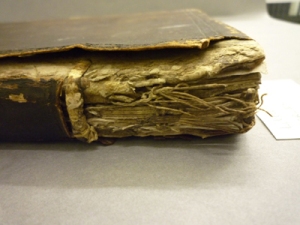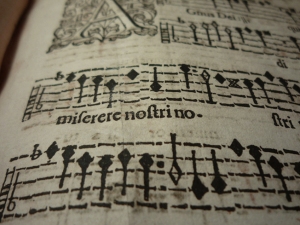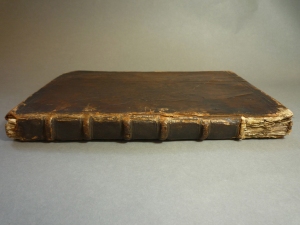Morley, Thomas, A Plaine and Easie Introduction to Practicall Musicke (London: Humfrey Lownes, 1608). The book comes from the library of Novello Chairman Alfred Henry Littleton, who collected landmarks of music printing.
First published in 1597, Thomas Morley’s Plaine and Easie Introduction to Practicall Musicke has been described as a piece of outstanding scholarship, which has retained its importance as a musical textbook (Oxford DNB). It is written in the form of a dialogue between master and pupil, with many examples of printed music. The music collection at Senate House Library provides witness to its lasting value, holding an Oxford University Press edition of the entire work from 1937 and Dent editions from 1952 and 1963. These are in addition to several scores selected from it. The book, in a 17th-century full calf leather binding, was at risk of further damage when it was requested.
 Many printed books that are referred for conservation in the library’s conservation studio have weak or broken board attachments. This book, sewn on alum tawed supports, had strong board attachments but the front board had bent up at the joint stressing the covering leather. The leather was broken along this part of the joint and areas were missing at the corners and spine. The book had other damage including loose sewing and torn text. The book needed remedial conservation to prevent the damage from getting any worse but it did not need to be heavily repaired, which would affect the evidence of the history of the book and its binding.
Many printed books that are referred for conservation in the library’s conservation studio have weak or broken board attachments. This book, sewn on alum tawed supports, had strong board attachments but the front board had bent up at the joint stressing the covering leather. The leather was broken along this part of the joint and areas were missing at the corners and spine. The book had other damage including loose sewing and torn text. The book needed remedial conservation to prevent the damage from getting any worse but it did not need to be heavily repaired, which would affect the evidence of the history of the book and its binding.
The first step was to strengthen the board attachment to prevent the leather tearing further along the joint.
A new strip of leather was inserted across the joint underneath the original leather. It was pasted down one side, on to the board and under the board leather. On the spine side it was only pasted to the underside of the leather to prevent the spine leather becoming too rigid and risk it breaking. The missing spine panel of leather which exposes the headband threads was not replaced because it was not an area that was vulnerable to further damage with careful use and storage.
The tail band threads were loose.
A piece of toned, thin, flexible Japanese paper was pasted to the spine to give a smooth base to paste the tie down threads onto.
The book is sewn onto alum tawed skin sewing supports which are then attached to the board. The bent edge of the front board may be due to shrinkage of the sewing supports combined with the stiff parchment endleaf guard and the heavy photographic paper of the facsimile title page catching the board as it closes. This title page was removed to try to soften the joint and will be kept with the book.
 The board was softened with water mixed with a little paste before drying it under pressure. The paste was to help the board stay flat. This was not totally successful because the board creased up again slightly as soon as the book was closed.
The board was softened with water mixed with a little paste before drying it under pressure. The paste was to help the board stay flat. This was not totally successful because the board creased up again slightly as soon as the book was closed.
No further attempts were made to avoid further stress to the alum tawed supports. There is less strain on the joint now because the leather has been repaired so with careful handling it should not get any worse.
PAPER REPAIRS
The text paper is thin with some worn, torn edges and with several knife cuts to the text leaves. The edge tears were repaired if they were likely to catch and extend during use.  The clean,sharp cuts are probably a result of the removal of the missing endleaves and the first few pages. Paper was expensive and it is not unusual for endleaves to be removed for re-use.
The clean,sharp cuts are probably a result of the removal of the missing endleaves and the first few pages. Paper was expensive and it is not unusual for endleaves to be removed for re-use.
These clean, sharp edged cuts running through the text meant that a series of small ‘splint’ paper repairs on both sides of the sheets were needed to prevent the repair paper obstructing the text.
The paper either side of the cut on the introductory page has distorted and the type, as you can see, does not match up precisely.
The repairs had to be stiff enough to stop the repaired page ‘peaking’ at the sharp join but discreet enough not to interfere with the text.
SEWING
The sewing was loose near the tail of the book.  Initially this was to be repaired with new stitches but on closer examination it was found that the book was sewn two-on. In this technique one length of thread picks up two sections in one stitch across the spine. This was common from the beginning of the seventeenth century in England to speed up the sewing. It meant every other section would need to have a new hole pierce the paper but this would disturb the historical evidence
Initially this was to be repaired with new stitches but on closer examination it was found that the book was sewn two-on. In this technique one length of thread picks up two sections in one stitch across the spine. This was common from the beginning of the seventeenth century in England to speed up the sewing. It meant every other section would need to have a new hole pierce the paper but this would disturb the historical evidence  of the binding structure.
of the binding structure.
Therefore, the loose sections were eased back into position in the book and, where possible, strengthened by pasting them into position on the spine.
These minimal repairs do not intrude on the original binding and with considerate handling and a benign storage environment the book will be functional for future generations.







